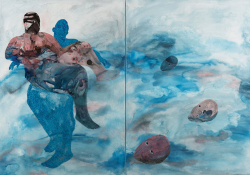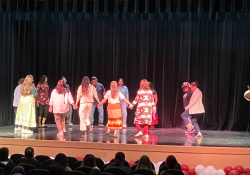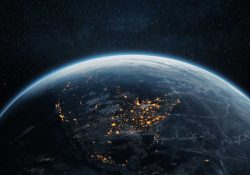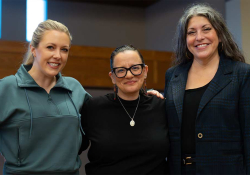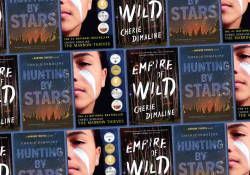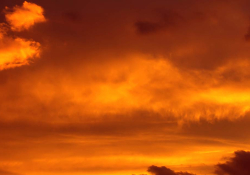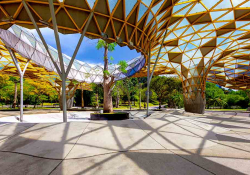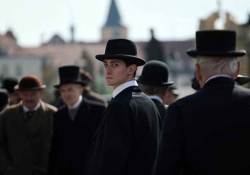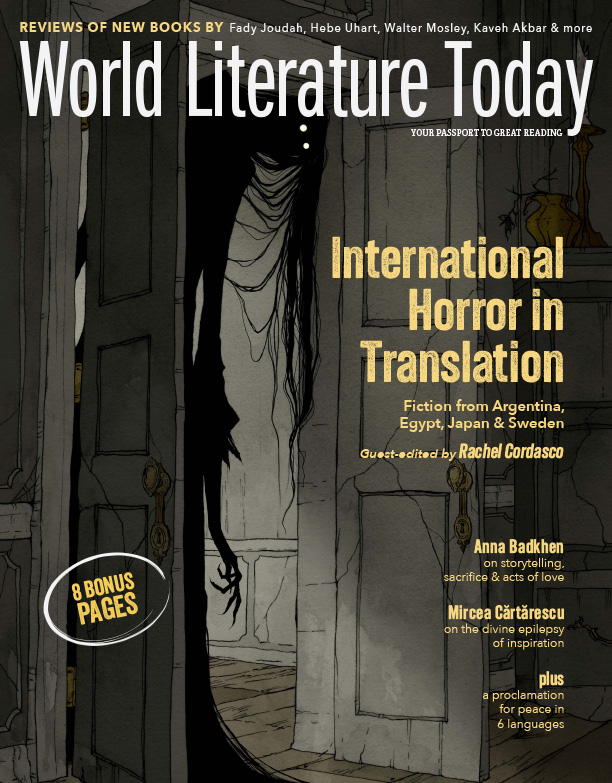Another Way to Begin
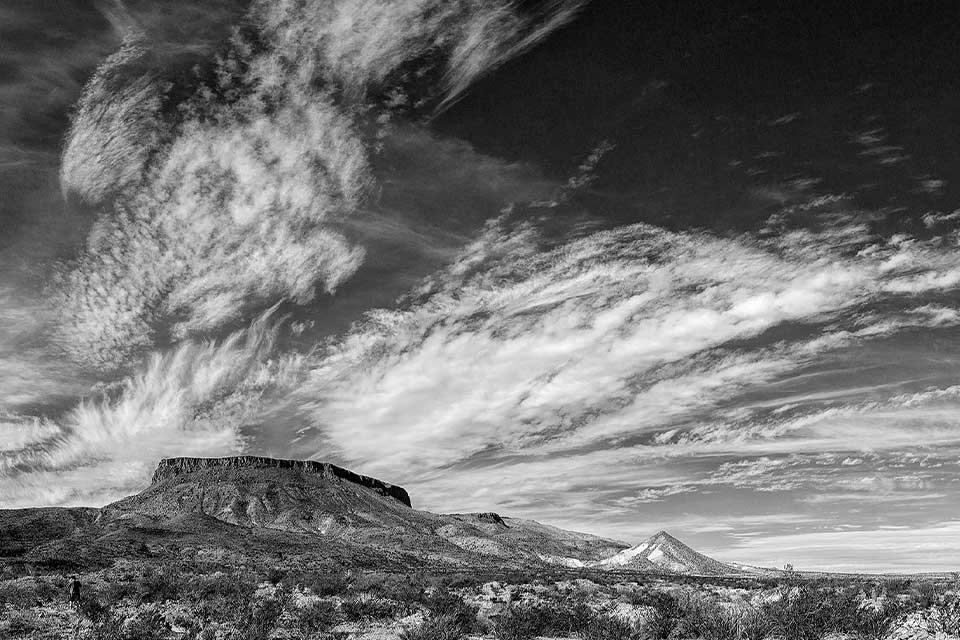
Can we tell stories, the author asks, “in a way that makes more breathing room, that does not crush humans, not even one, not even a little girl?”
Once upon a time, the story goes, in a village in the northern Chihuahuan Desert—like the ones that today crumble to clay dust on either side of the Río Grande—there was a drought that unleashed a famine so terrible, people were eating their dead. In one family, the sole survivor was a little girl.
There are many versions of what happened to the girl. In one, she walked up a mountain to sacrifice the tattered blue rag doll her parents had made for her out of buckskin and feathers, and the next day it rained and bluebonnets bloomed and buffalo arrived to graze in them; the starving villagers killed a buffalo and the fast was broken. In another, it was her blue dress the girl sacrificed, and it rained, and bluebonnets bloomed, and buffalo arrived to graze in them. In another, the village elders sacrificed the girl herself, and where her blue rebozo fell to the ground so did the rain, and bluebonnets bloomed, and buffalo arrived to graze in them. A story depends on the bigheartedness of the narrator, and it depends even more on the bigheartedness of the audience, on how much grief they are willing to hold.
How much grief are we willing to hold? The photo that ended the Vietnam War, a latter-day story goes, was Nick Ut’s 1972 image of the nine-year-old Phan Thi Kim Phuc running naked down Route 1 from a napalm raid on Trảng Bàng. The photo that may have shaken the United States’ resolve in Iraq was of five-year-old Samar Hassan covered in her parents’ blood in Tal Afar in 2005, taken by my late friend Chris Hondros. Will the recording of six-year-old Hind Rajab in Gaza, calling the Palestinian Red Crescent from a car full of her murdered relatives before Israeli troops kill her, too, alter the course of the genocidal apartheid in 2024? Perhaps—or perhaps not: our capacity for grief is elastic, ever-stretching. After all, as Jane Hirshfield writes, “The world asks of us / only the strength we have and we give it. / Then it asks more, and we give it.”[i]
* * *
What kind of stories are we telling ourselves? Why do we take it for granted that our survival on this planet requires the sacrifice of a girl; why does it require of a girl a sacrifice? I return, again and again, to the interview in which James Baldwin says that “the world is held together . . . by the love and compassion of very few people.” “You could be that monster, you could be that cop,” Baldwin says. “And you have to decide, in yourself, not to be.”[ii]
I agree: the decision to love—to be kind—to wonder—is a kind of labor. It is not automatic or even natural to us as we grow older; we must make a real effort, make it a discipline even. I want to believe that the magic and the curse of being human is that we hold both violence and love. But why do we keep sacrificing the little girl in order to live in love, keep chaining the maiden to the cliff to feed the dragon of our violence?
Why do we keep sacrificing the little girl in order to live in love, keep chaining the maiden to the cliff to feed the dragon of our violence?
In his 1987 Jerusalem Prize acceptance speech, J. M. Coetzee described the fundamental sin of apartheid as “a failure of love”: “The deformed and stunted relations between human beings that were created under colonialism and exacerbated under what is loosely called apartheid,” he said,
have their psychic representation in a deformed and stunted inner life. All expressions of that inner life, no matter how intense, no matter how pierced with exultation or despair, suffer from the same stuntedness and deformity.
The literature that is born of that deformity, he said, “is less than human literature, unnecessarily preoccupied with power and the torsions of power, unable to move from elementary relations of contestation, domination, and subjugation to the vast and complex human world that lies beyond them. It is exactly the kind of literature you would expect people to write from a prison.”[iii]
Will we ever stop telling stories from a prison?
* * *
On the Texas side of the Río Grande, there is an old adobe hamlet with a church, power lines, and a telephone cable. It has no school, no police station, no gas station, no Internet or cell phone network, no grocery store or taco stand, though there is—or was, when I lived nearby—a lady who made excellent tamales and sold them to her neighbors. Most of the villagers descend from the people who had lived in the Chihuahuan Desert since before mammoths went extinct, who hunted buffalo in its iambic vastness, who dreamed bluebonnet salvation before European armies arrived and unsaw them and invaded their desert. Most houses in the hamlet sit along a two-lane paved road that slips between the river and a nature preserve. The preserve is popular among birdwatchers and hikers, city people who come here to exhale from office work and inhale the creosote blessing of desert rain. They drive high-clearance vehicles through the heart of the hamlet. To describe the desert quiet, they commonly use the pronoun nobody, shorthand for nobody I care about, as in There’s absolutely nobody here!
One of the adobes facing the road belongs to my friend Enrique Madrid, a scholar, translator, mystic, and keeper of tradition who teaches an occasional workshop on Jumano practices, and his wife, Ruby, a retired social worker who keeps an extensive library of cookbooks, including one entirely dedicated to dishes you can make out of Spam. Enrique’s Borgesian library seems to contain everything else. Outside, in December and January, the cold months, an immense, undulating toad of smog the color of dirty dishwater often squats upon the desert.
Inversion, Enrique explains. Cold air blows into the gorge and weighs down whatever weather we have. Traps it close to the ground. Keeps down all the smoke we produce around here with all of our cooking and our heating and our breathing.
A dragon’s breath, I think, keeping the village at bay.
We are in Enrique’s kitchen, where I am grating beets onto a wooden cutting board scooped concave by decades of use. Kettles and griddles and cast-iron saucepans hang suspended on hooks and nails between vials and plastic bottles of old-looking medicine frosted with years of dust, and there are calcified bouillon cubes, cracked china, coffee makers for espresso and Turkish coffee and French press, and pitcher upon pitcher stuffed with bouquets of silverware and skimmers and ladles and spatulas and whisks and tongs and knife sharpeners. It is a kitchen from that part of a folktale in which the little girl, lost in a forest, stumbles at last upon a sorcerer’s cabin and is asked to perform a task. I am performing the task of cooking borsch for lunch. Borsch was my grandmother’s signature dish.
I have offered to cook for Enrique and Ruby because I like cooking for friends. It’s a fondness that strengthened during my years as a war correspondent; breaking bread in extremis is an act of love. Another reason I wanted to cook is that only by the stove is it not bone-achingly cold. Enrique is not heating the house this winter.
Breaking bread in extremis is an act of love.
Too expensive, he says. We simply wear many layers, like Indians.
He is wearing woolen dress pants and two flannel shirts, one over another, and a brown, frayed woman’s rebozo over that. Around his neck is a string he has made with twenty-four plastic beads of different colors, a mnemonic for his pill regimen. Diabetes has already taken his right leg. Now it is threatening his sight. Occasionally, I drive Enrique to visit an eye doctor in El Paso, four hours away. We squeeze into my little car and drive west to Presidio and from there hook north. When we approach each border-patrol checkpoint, Enrique fidgets in the passenger seat, hides his worn copy of Neruda’s Canto General under his fedora.
What are you doing, Enrique?
Camouflaging. A white woman at the wheel may not be enough to protect my Indian body and my communist poet.
The dragon, I remember, is a shape-shifter, a many-headed beast.
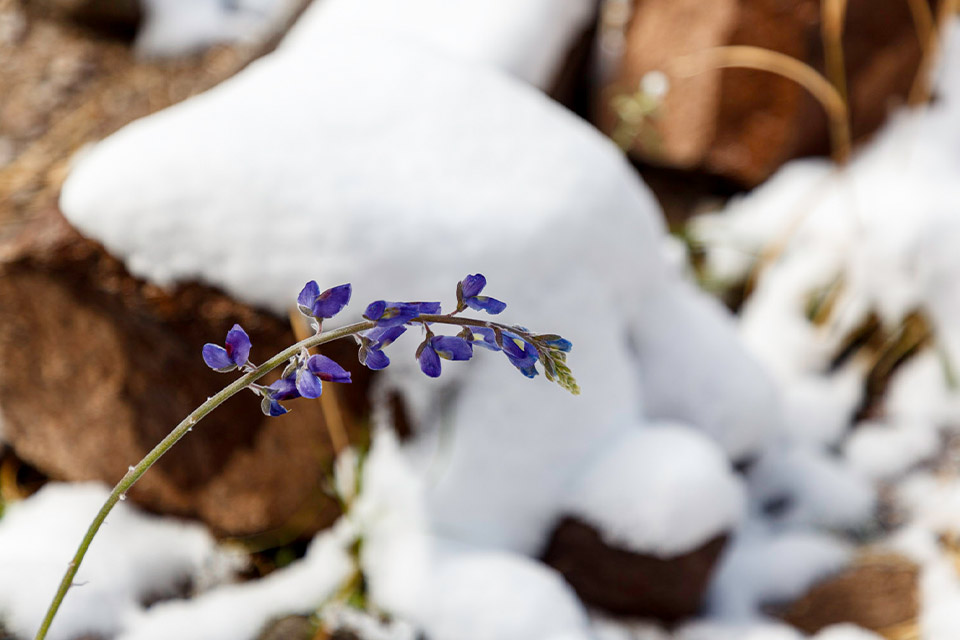
The dragon, I remember, is a shape-shifter, a many-headed beast.
Steamed up against the heavy cold, Enrique and Ruby’s home breathes in, breathes out. In a folktale, the sorcerer’s house stands on the border between two worlds and the hero must enter to gain onward passage; in Enrique’s house on the border river, emissaries of other worlds have entered the rooms and guard its inhabitants. I can feel them looking at me: a menorah welded from rusty water pipes, small altars of conch shells and cowries, a wind chime, a faded Our Lady of Guadalupe in a rebozo with a monochrome US flag pattern, a photograph of Subcomandante Marcos, a wicker basket with newspaper clippings, a mezuzah on the door, a white stuffed toy rabbit, a crucifix. Enrique’s cosmogony accommodates everything. To live on the border, he says, you have to become a mystic.
* * *
Speaking of mystics: centuries after the famine in the pueblos, and south of the Río Grande, it is said, the girl from that old folktale paid a visit to a Chichimeca elder named Juan Diego Cuauhtlatoatzin. She appeared to him as the blue-robed Virgin of Guadalupe—or Coatallope, She Who Treads on Snakes. Another hundred years passed, and a Spanish abbess and mystic named Sister María de Jesús, née María Fernández Coronel, appeared, dressed in blue, before Jumano villagers on the Río Grande without ever leaving her cell in Ágreda; between 1621 and 1631 she bilocated to the desert from Spain more than five hundred times and left bluebonnets in her wake. On the river they now call her the Lady in Blue. She did not bring any buffalo, only the Gospel.[iv] But thousands of years before that, another story goes, in the prairie far to the north of the river, a woman in white buckskin appeared to Lakota villagers during a famine to teach them respect and mindfulness toward their resources—and, having spoken, fell to the ground, rolled over four times, and became a white buffalo. After she left, a herd of buffalo appeared and allowed the starving villagers to slaughter one of its own so that the humans would survive.[v]
You see? It is possible for us to dream a world in which the girl, the maiden, is perfectly fine.
* * *
My grandmother—in the family we called her Babushka—was still alive when I cooked borsch for Enrique and Ruby, though fading. She was born in Leningrad in 1927 and had lived there her entire life, through Stalin’s purges, which killed at least one of her relatives, and the rest of communism, long enough to celebrate the fall of the Soviet Union, the return to her city of birth its maiden name, St. Petersburg, and the birth of two great-grandchildren. The day she died, at the age of ninety-one, I was seven thousand miles away at a writing residency on the south-facing slope of a volcano on the Hawai’ian island of Maui, where, like a little girl would, I swam and walked and ate things off trees, off the ground: guava, oranges, avocado, limes, lilikoi. I ate them indiscriminately and with greed, my mouth an extension of my eye, an eye that gorged. There was birdsong and the wind smelled like ginger flowers and rotting guavas. Maui seemed to be made of taste, of texture, of pattern. I had been on the island a week when Dad’s email arrived from St. Petersburg early in the morning.
There was no cell phone network inside the house on Maui. To call Mama, I stepped through the French doors onto the veranda that faces downslope. Beyond the jungle’s dappled rim the Pacific shone a blue that hurt the eye. A small black moth had latched itself to the veranda door.
Across thirteen time zones Mama and I cried with each other on the phone. We told each other our love, our sadness. Before she hung up, Mama said: Be in beauty today, maybe she will fly by to visit you.
I walked down from the veranda and onto the highway, past road signs that mark the boundaries of erstwhile land divisions. Ka ‘Aina O Ka Makani Ka’ili Aloha: Land of the Love-Snatching Wind. Ka ‘Aina O Ka Ua Pe’e Pohaku: Land of the Rain That Makes One Hide Behind Rocks. Ka ‘Aina O Ka Ua Kea: Land of the White Misty Rain. These are nostalgic markers; sugar barons redrew the administrative map of the island, just as they redrew the political and demographic maps of Hawai’i. They displaced its people, drained its waters, chopped its native forests. Nostalgia, a word that the seventeenth-century Swiss doctor Johannes Hofer “composed of two sounds, the one of which is Nosos, return to the native land; the other, Algos, signifies suffering or grief,” to diagnose displaced people’s “grief for the lost charm of the Native Land.”[vi] In Hawai’i, as in many parts of the world remapped by conquest, it is possible to grieve the lost charm of the Native Land while standing right on it.
More names. Kipahulu, the town in which I was staying: Fetch from Exhausted Gardens. Waimoku, the big waterfall where I picked guava fruit from trees: Water That Amputates. A rain squalled in. The ocean became banded, a dented drum beneath a bulging sky. When I returned to the house, I tracked powdered volcano on my feet onto the veranda, and the moth was still there, on the screen door.
* * *
While I cook borsch, Enrique piles books and magazine clippings onto the kitchen counter and tells border stories. How a US Marine had shot a local teenage boy twenty years before and how the apiaries near that spot are said to yield black honey. How asadero makers across the river use belladonna in their cheese curds, and how each wheat tortilla, when you make it properly, is a model of the universe, expanding omnidirectionally under the evenly applied pressure of a rolling pin. How wheat tortillas are transatlantic immigrants, patas mojadas—wetbacks—brought to Andalucía from the Maghreb by the Moors, then to the Americas by the colonizers from Spain. How when he was young the border was open and herders took flocks across the river and back to graze.
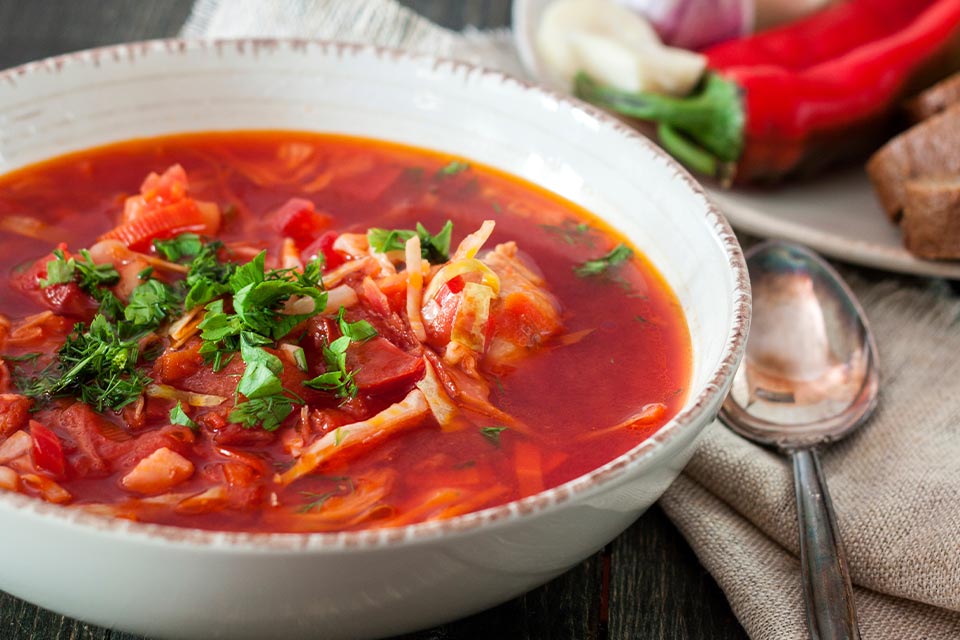
Each wheat tortilla, when you make it properly, is a model of the universe, expanding omnidirectionally.
Enrique opens a book to a centerfold map of the border and traces the line with a finely shaped, clean fingernail.
The new morality of North America will be born here, he says. But I don’t know how much more I can take this, this life on the border. I don’t have any hair to turn gray left.
I stir in the cabbage and think: formed out of rupture, we are ecotone creatures, always straddling borders, the gritty membranes that resonate and amplify our most intimate aspirations and frustrations. The intricacies of life are shaped within such precarious balancing. Exploring borders and boundaries allows for an introspection, a questioning: Where do I draw my own?
Then he shuts the book and tells me his dream:
I am invited to be a guest on an NPR show, but there is no room for me to sit in the studio. Wherever I try to have a seat they say, “It is occupied, try looking over there.”
What do you think this dream means? I ask.
He shrugs inside that brown rebozo. I have no place in this country, he says. There is no room for me here.
I scrape the shredded beets into the boiling pot of cabbage broth on the stove. The beets bleed carmine, the same color as the dye people in this desert have learned to crush out of female cochineal insects, the blood-red pigment that funded Spain’s occupation and looting of the Americas,[vii] of this very desert. Soon the soup is a bubbling crimson eye, and when I carry the pot across to the dining table all the heat in the winter room moves with it. My hosts wait at the table.
I serve the soup. Enrique wields a spoon over his plate like a scepter and recites a benediction:
I am going to call this soup el borsche. It is the first time in the history of the universe, thirteen-point-five billion years, that el borsche was prepared on the border. It’s part of the magnificence of the frontier!
Amen, says Ruby, and laughs.
* * *
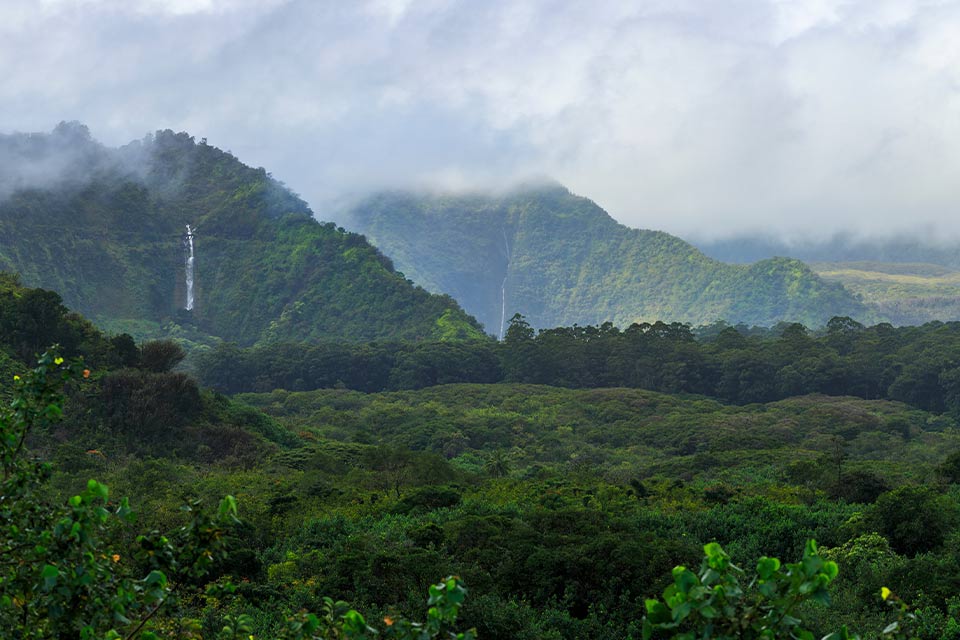
The story says that the island of Maui was named after a man named after a demigod. This Maui was the son of Hawai’i Loa, the legendary fisherman who is said to have discovered the Hawai’ian islands and named them after himself, his children, and his navigator.[viii] The demigod, Maui, was not a successful fisherman and was not very well liked by his family: his mother scolded him, his brothers ridiculed him. But one day he did hook a submerged archipelago with his fishing line and hauled it out of the sea. Then he slowed down the sun, so his mother’s laundry would have enough time to dry, and pushed the sky higher to give humans more breathing room. In other words, he created a new landscape, and then he created space-time.
This is what we do when we tell stories: we try to slow down time, or at least to make an imprint of it, a kind of a memory. Can we do it in a way that makes more breathing room, that does not crush humans, not even one, not even a little girl? It is not a question of how we have allowed ourselves to get here—but of how we can get from here to wherever we are going.
* * *
Once upon a time, after a supper of tough flatbread and wild honey, I sat in a fenced-in compound in the African Rift Valley in Ethiopia, one of the places where Homo sapiens told our first stories. In his Nobel Prize acceptance speech in 1975, Eugenio Montale said: “I consider poetry, materially speaking, to be born of the necessity to connect a vocal sound (the word) with the hammer beat of the earliest tribal music.”[ix] And I guess the patch of laterite dirt where I was sitting could have been one of the places where poetry, materially speaking, was born. Another poet, Gary Whited, reminds me that “the first border between Eden and everything not Eden arose out of a reach for knowing, or was it a reach for a story, and look how so many have ‘sacrificed’ Eve/the feminine over this story.” Perhaps the Middle Awash, which many scientists believe to be our biological Eden, was once the site of such earliest sacrifices. Among these sacrifices was the genital mutilation of young girls, most likely, writes the Somali-born archaeologist Sada Mire, “meant as a collective human sacrifice to the gods to avoid a curse from the ancestors” that could “materialise in a lack of rain, failed crops, droughts, dead livestock and illness.”[x] To this day, most girls in the Afar region undergo infibulation, a complete removal of the clitoris and the labiae.
My host, Ahmed Elema, was a balabat, a hereditary Afar clan leader; he was as old as my parents, and I addressed him, respectfully, as Uncle. But to myself, I called him Archangel, after Uriel, the cherub who guards the Garden of Eden, the dispenser of knowledge who, in the Hebrew tradition, gave Kabbalah—a way of storying the Bible—to the Jews.
Uncle Ahmed was an enthusiastic archangel, and that evening he was telling stories to his grandnieces and nephews, stories that I imagined began with once upon a time, or one day, or let me tell you a story. I could not know for sure because I do not understand Afaraf and because I dared not interrupt—this was too sacred for interruption. This was how Babushka was a storyteller, how I, mesmerized, would overstay my bedtime just to know what happened then, and then what happened, and how does it end. A southbound storm flashed on the horizon, and I remembered that Uriel is the angel of repentance who watches over thunder and terror,[xi] who greets the souls of the dead when they cross into the next world and escorts the souls of sinners to hell—or guides the souls of the faithful into heaven: Uriel the border guard, the coyote, the human trafficker. But he is also the angel of hope and music, responsible for divine visions.
Uriel the border guard, the coyote, the human trafficker, is also the angel of hope and music, responsible for divine visions.
Another lightning, and I glanced at my host. Uriel is often portrayed enveloped with fire; sometimes he carries a flaming sword or it is his wings that seem aflame. Often fire comes out of his bare palm, and I half-expected to see something in Uncle Ahmed ablaze. But what I saw when we caught each other’s eye was a joyful, generous smile of a man at ease, at home. Suddenly, stirred by some signal imperceptible to me, all his young grandnieces lifted off their mats in a passerine cloud, clustered just outside the compound’s wattle fence, and started a clapping game, putting poetry to palmstrokes. The song bounced off the scrubland, all the way to the beginning.
Philadelphia
[i] Hirshfield, “The Weighing,” in The October Palace (Harper Collins, 1994).
[ii] Baldwin, “Love Has Never Been a Popular Movement” (1970), YouTube.
[iii] Coetzee, Doubling the Point (Harvard University Press, 1992), 97–98.
[iv] “Sister María de Jesús de Agreda,” CatholicSaints.Info.
[v] “Hawaiiloa and Paao Migrations,” Internet Sacred Text Archive.
[vi] Hofer, “Medical Dissertation on Nostalgia,” 1688; reprinted in Bulletin of the Institute of the History of Medicine 2, no. 6 (August 1934), 376–91.
[vii] C. M. Salinas, “Mexican Cochineal, Local Technologies and the Rise of Global Trade from the Sixteenth to the Nineteenth Centuries,” in Global History and New Polycentric Approaches, ed. M. Perez Garcia & L. De Sousa (Palgrave Macmillan, 2018); Raymond L. Lee, “Cochineal Production and Trade in New Spain to 1600,” The Americas 4, no. 4 (1948): 449–73.
[viii] Samuel M. Kamakau and Z. Kepelino, “Hawai‘iloa and the Discovery of Hawai‘i.”
[ix] Montale, The Second Life of Art: Selected Essays, ed. and trans. Jonathan Galassi (Ecco Press, 1982), 51.
[x] Sada Mire, “We Won’t Eradicate FGM if We Keep Misunderstanding Its History,” The Guardian, March 9, 2020.
[xi] Enoch 2:20.

